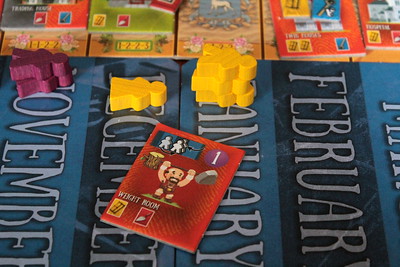| Strategy | Luck |
|---|---|
| Interaction | Components & Design |
| Complexity | Score |
Well, not so when you start building the city of Samara. Corné van Moorsel’s Samara is all about time. The game’s basic unit of time is still a month, but how many months something takes and how many people you need to accomplish it, that’s where things get way more interesting.
Going with the times – how to play Samara
Your goal in Samara is to collect the most prestige points with building projects in the city of Samara. Today, Samara is one of the ten largest cities in Russia, but building all that would take too long. The game’s Samara will be a nice, small city with thirty-six buildings.
Time is the factor deciding almost everything in Samara, and the game board makes that clear from the start. Below the main board you have the two piece timetrack where everyone’s workers wait their turn. A worker’s turn comes when their month arrives at the current month marker. Starting with the worker closest to the board, their owner uses that worker to take an action.
The action you’re mostly interested in is, of course, to build a building. For most buildings, however, you need the right tools first. For simple wood buildings, you need a Saw. Stone buildings are more complex and need both a Trowel Compass and a Trowel Square. Finally, buildings with a lot of glass require Glass Tool A and Glass Tool B – I’m sure there were more creative names available – and they can only be acquired in the right order.
Acquiring tools and using them to construct buildings follows the same rules. On the main game board you have a grid, and on that grid you find both buildings and tools. To see the price for a tool or building, you look at its position on the grid. The row tells you how much strength you need. A regular worker has one point of strength, but sending a worker to the Weight Room – I’m not kidding about this, it’s the actual building you need – lets them buff up with an extra point of strength. The column on the grid tells you how long it takes to take a tool or building. For each column, the workers you use go one month further into the future on the timetrack. That’s how long they’ll take to complete whatever you send them to do.
You have two other actions your workers can take. One, they can take a nice vacation. That simply moves a worker forward on the time track until they meet your next worker there. When you’re planning on a big project, this is the easiest way to get your workers into the same month.
The final action… well, you know how worker placement games let you get new workers. Have you ever wondered where those new workers come from? In Samara, you have men and women working for you, and when you move a woman worker all the way to the end of the time track you may place a new worker next to her. When that workers time comes they’re immediately ready to pick up their shovel and walk to the next job.
The only thing left to talk about is how some of the buildings you’ll construct have special effects. Some make you lose a tool used to build them, so you’ll have to acquire a new tool of that kind. Barracks make every other player lose a tool, but that is the only direct interaction between players. I’m a big fan of the School, personally, because it teaches the benefits of teamwork. When you have a School and send two or three workers to work together on a project, they get an extra point of strength. There are more special effects, but not that many. There are only thirty-six building tiles, after all.
A good use of your time? Our Verdict
Those last two sentences above sum up my feelings about Samara, unfortunately. “Not that many”, “there are only”… my one big complaint is that I wanted more.
I’m in love with the timetrack mechanism. To be entirely honest, I’m not that happy with that whole birthing new workers thing, but other than that I love the timetrack. It’s very thematic for a game where you construct buildings, at the same time it’s a lot of fun to plan with. When is a long time waiting for your workers to be ready again worth more than two smaller projects? Is an unproductive vacation really the best way to bring your workers into the same time zone, or can the two teams maybe each take on shorter projects that will finish at the same time? And does the delay from that give your opponents a chance to take the thing you wanted?
What doesn’t work for me is what Samara does with that timetrack. Take tools, build buildings, it’s bland. I enjoy a lighter game as much as most players, but Samara doesn’t feel like a light game. It feels like a proof of concept for a medium or even heavy game that is missing the rest. And that’s just a shame, because I would love a heavier game using the timetrack mechanism.
It’s been five years. I’m ready for the full game now!




